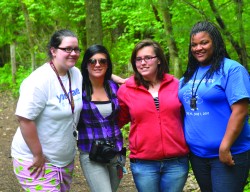
Peoria Regional High School at Wildlife Prairie Park offers students a fundamental education experience in a unique learning environment.
Some were bullied. Some were socially awkward. Some were coping with difficult family situations. Some lacked motivation. But all the students at Peoria Regional High School at Wildlife Prairie Park share a reasonable chance for success, explains director Randy Stueve.
This fall marks the beginning of the school’s second year at its new site. The program was launched at the conclusion of the long-standing Academy Program at ICC—an alternative high school designed to service over 100 students from Tazewell, Woodford and Peoria counties. “When that program ended,” explains Stueve, “there was a huge hole in the safety net for a bunch of kids.”
Despite having been retired for five years, Stueve did not hesitate to join Gerry Brookhart, Peoria’s regional superintendent of schools, in finding a place for the displaced students. They set their eyes on Wildlife Prairie Park, where they were welcomed with open arms by then-general manager, Jeanne Williamson, former superintendent of Dunlap School District. “They had the space, and they needed a revenue stream. We needed a space and we had a revenue stream,” explains Stueve.
The program employs three full-time and two part-time teachers to instruct approximately 50 students each semester in math, science and language arts. The school day is typical—seven 50-minute periods, 8:30am to 3pm, Monday through Friday. And the expectations are typical—standard behavioral and attendance guidelines are enforced. But it’s the environment that sets this program apart.
Lessons lean environmental. It’s not uncommon for students to take in a lecture outdoors, engage in a class hike, or spend an afternoon learning how to fish. Teachers take advantage of the park’s many activities and programs throughout the year, and vice versa: the park makes use of students as volunteers.
The program caters to the “average 15 percent of students who are unable to function within the public school system,” but Stueve begrudgingly admits that there are not enough resources to account for all 15 percent. “We’re looking for kids that have a reasonable chance for success. They’re not hardcore violent or expelled gang [member] types. That’s not the mission for this particular situation… These kids come to us on a referral basis.”
The program’s small size, family atmosphere and ability to cater to each individual’s academic and social needs, without the distractions and drama entailed with “regular” high school, allow students to be successful here, he explains. “Here, kids are just kids.”
Sixteen students graduated in the school’s inaugural class this spring, the diplomas issued by each student’s home school institution. Despite the administrative hassle, Stueve believes this will pay dividends for the kids down the road.
The program is a work in progress, he notes. But with a willingness to adapt, the school is forging ahead this fall, incorporating more interdisciplinary projects into the curriculum. In one project last spring, the students created a short video about their experience at the school. In the video, one student declares, “I don’t want to be a dropout…so I’m here.” Another adds, “Here, nobody judges me.”
“All of us come here for different reasons,” says another. “For a second chance…a new beginning…a different experience.” iBi

